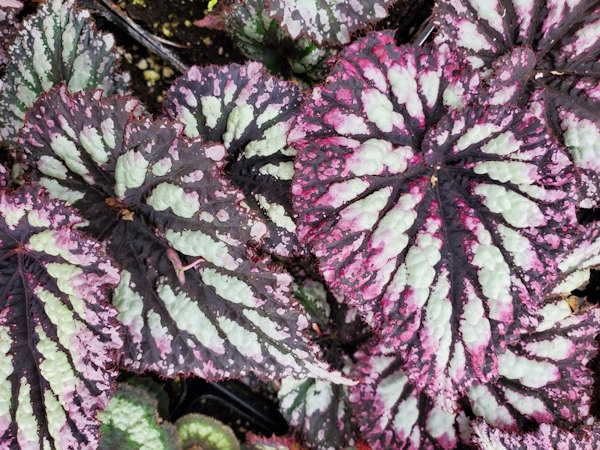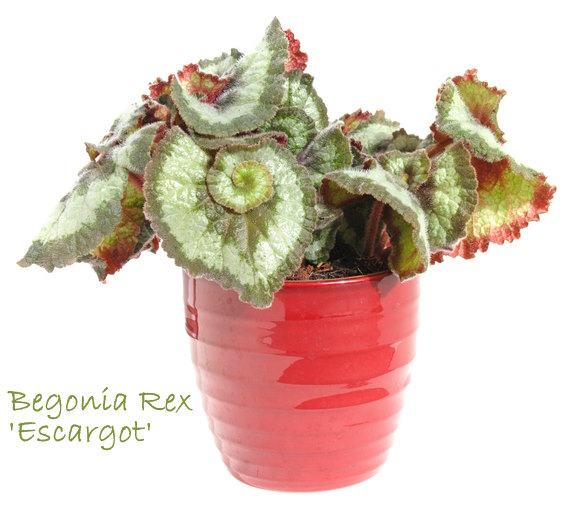Rex Begonia Care
Rex begonia houseplants are cherished for their dramatic colorful and textured leaves. Hundreds of hybrids are available, each one captivating on its own. Fortunately, we don't have to choose just one. These fancy-leafed begonias are breathtaking when displayed together.
In this guide, you'll discover how often to water, when to fertilize, what to do when your begonia goes dormant (don't give up on it!), plus how to propagate these beauties for more houseplants.
 Begonia rex 'Fireworks' is one of the most popular cultivars. It's easy to see why. Image by ©Khairil Junos | Dreamstime
Begonia rex 'Fireworks' is one of the most popular cultivars. It's easy to see why. Image by ©Khairil Junos | DreamstimeGet to Know Rex Begonias
Known botanically as Begonia rex, this is a long-time favorite of house plant lovers. It is native to Southeast Asia and India, where it thrives in the year-round warmth and humidity.
These fancy-leafed begonias produce dramatic, wing-shaped leaves streaked, veined, or splashed in shades of silver, pink, purple, cream, green, red, or burgundy.
Small flowers may grow on tall stems. It's up to you whether you want to keep them. Flowers use the plant's energy, which is better used to grow those magnificent leaves. If you want, you can pinch off the flower stems to encourage larger leaves.
This begonia is rhizomatous, growing from a thick, fleshy rhizome that grows just below the surface of the soil. Repot in spring when the rhizome outgrows the pot. Because rhizomes have shallow roots, a shallow pot will do.
How big does rex begonia get? It has an upright growth habit, and may grow up to 1 ft (30 cm) tall, depending on the variety.
Rex begonia can be difficult to grow because of its need for high humidity. Dry, brittle leaves are a symptom of dry air. A terrarium, Wardian case or glass cloche may be just the solution for your humidity-loving rex begonias.
Begonia Rex Varieties
There are 100s of hybrids to choose from. Some are upright, but most are low-growing. Choose the one you like...they're all spectacular.
Some of the many popular named varieties include: 'Merry Christmas' in red and green... 'Fireworks' is stunning with silvery green, black and purple markings... 'Escargot' (shown at bottom) is popular for its snail-like spiral-shaped leaves.
Dwarf types are ideal for dish gardens and terrariums.
Rex Begonia Problems and Solutions
Dropped leaves? Fancy-leafed begonias sometimes drop their leaves and become dormant in the winter. If this happens, cut off the withered leaves, stop watering, and enclose the plant in a plastic bag. Keep it at 60°F/16°C until new growth appears, in approximately 6-10 weeks. Then continue with normal care.
Dry, crispy leaves may be a symptom of dry soil, dry air or direct sunlight. Keep rex begonia in bright, indirect light and boost the humidity around it.
Yellow leaves are caused by overwatering. It's a good idea to use a small pot with drainage holes. Water thoroughly, then empty drainage tray. If you want to use a cachepot (a pot without drainage holes), slip a plain nursery pot into the cachepot. Put pebbles in the bottom of the cachepot to keep the inner pot above the drainage water.
Spots on leaves are typically fungal-related. Spots with yellow halos are bacterial leaf spot. Tan spots are a symptom of botrytis fungus that attacks plants in cool, wet conditions. Cut off affected leaves and increase air circulation around your plant. Warm sunshine will help prevent fungus.
Something bugging your begonia? Check your plant for aphids (they're attracted to soft, new growth) and fungus gnats (that are drawn to wet, peaty potting mixes). Treat any infestation right away. Don't use an insecticide spray on rex begonias because it will damage them.
Is rex begonia poisonous? Yes -- it contains calcium oxalate that is extremely toxic to cats and dogs. It's not a good choice for a home with curious pets that may play with or chew on plants.
 Image credit: Tamara Kulikova / istockphoto
Image credit: Tamara Kulikova / istockphotoRex Begonia Care Tips
Light: Bright light, but no direct midday sun in summer, which can scorch the leaves. Thrives under fluorescent light, which will help these fancy-leafed begonias keep their color and variegation.
Water: Keep soil evenly moist at all times, but be careful not to overwater because the rhizomes are prone to rot in soggy soil. Avoid getting water on leaves because water may cause bacterial leaf spot. Yellow leaves are a symptom of soggy soil.
Humidity: High humidity is a must. If the relative humidity drops below 50%, stand the pot on a tray of wet pebbles, or use a small humidifier. Do not mist because water can cause spots to form on leaves. Dry air can cause dry, brittle leaves.
Temperature: Average room temperatures (65-75°F/18-24°C) all year-round.
Soil: Use a peat-moss based mix with added perlite and/or vermiculite for fast draining, such as African violet potting mix.
Fertilizer: Feed every 2 weeks spring through fall with a balanced (such as 10-10-10 NPK) water-soluble fertilizer at half the recommended rate on the package. Stop fertilizing dormant plants.
Propagation: Take leaf cuttings in spring or summer. Cut a healthy, medium-sized leaf with 1-2 in (2.5-5 cm) stem. Poke stem at a 45° angle in moist half-and-half mixture of peat moss and perlite. Enclose the whole thing in a plastic bag to hold in humidity. Keep the cutting in a warm spot (75-80°F/24-27°C) in indirect light. Leaf cuttings usually root in about 3-4 weeks, but it takes about another 4 weeks for plantlets to form. Pot up each plantlet when it has 3 leaves, and cut away the parent leaf.


